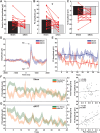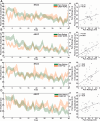Low-Intensity Focused Ultrasound to the Human Dorsal Anterior Cingulate Attenuates Acute Pain Perception and Autonomic Responses
- PMID: 38182418
- PMCID: PMC10883612
- DOI: 10.1523/JNEUROSCI.1011-23.2023
Low-Intensity Focused Ultrasound to the Human Dorsal Anterior Cingulate Attenuates Acute Pain Perception and Autonomic Responses
Abstract
The dorsal anterior cingulate cortex (dACC) is a critical brain area for pain and autonomic processing, making it a promising noninvasive therapeutic target. We leverage the high spatial resolution and deep focal lengths of low-intensity focused ultrasound (LIFU) to noninvasively modulate the dACC for effects on behavioral and cardiac autonomic responses using transient heat pain stimuli. A N = 16 healthy human volunteers (6 M/10 F) received transient contact heat pain during either LIFU to the dACC or Sham stimulation. Continuous electroencephalogram (EEG), electrocardiogram (ECG), and electrodermal response (EDR) were recorded. Outcome measures included pain ratings, heart rate variability, EDR response, blood pressure, and the amplitude of the contact heat-evoked potential (CHEP).LIFU reduced pain ratings by 1.09 ± 0.20 points relative to Sham. LIFU increased heart rate variability indexed by the standard deviation of normal sinus beats (SDNN), low-frequency (LF) power, and the low-frequency/high-frequency (LF/HF) ratio. There were no effects on the blood pressure or EDR. LIFU resulted in a 38.1% reduction in the P2 CHEP amplitude. Results demonstrate LIFU to the dACC reduces pain and alters autonomic responses to acute heat pain stimuli. This has implications for the causal understanding of human pain and autonomic processing in the dACC and potential future therapeutic options for pain relief and modulation of homeostatic signals.
Keywords: anterior cingulate; autonomic; contact heat; focused ultrasound; heart rate variability; pain.
Copyright © 2024 the authors.
Conflict of interest statement
The authors declare no competing financial interests.
Figures










Similar articles
-
Low-intensity focused ultrasound to the human insular cortex differentially modulates the heartbeat-evoked potential: a proof-of-concept study.bioRxiv [Preprint]. 2024 Mar 13:2024.03.08.584152. doi: 10.1101/2024.03.08.584152. bioRxiv. 2024. Update in: Clin Neurophysiol. 2024 Nov;167:267-281. doi: 10.1016/j.clinph.2024.09.006. PMID: 38559271 Free PMC article. Updated. Preprint.
-
Non-invasive neuromodulation of sub-regions of the human insula differentially affect pain processing and heart-rate variability.bioRxiv [Preprint]. 2023 May 5:2023.05.05.539593. doi: 10.1101/2023.05.05.539593. bioRxiv. 2023. Update in: Pain. 2024 Jul 1;165(7):1625-1641. doi: 10.1097/j.pain.0000000000003171. PMID: 37205396 Free PMC article. Updated. Preprint.
-
Noninvasive neuromodulation of subregions of the human insula differentially affect pain processing and heart-rate variability: a within-subjects pseudo-randomized trial.Pain. 2024 Jul 1;165(7):1625-1641. doi: 10.1097/j.pain.0000000000003171. Epub 2024 Feb 1. Pain. 2024. PMID: 38314779 Free PMC article. Clinical Trial.
-
Deep brain stimulation of the dorsal anterior cingulate cortex for the treatment of chronic neuropathic pain.Neurosurg Focus. 2015 Jun;38(6):E11. doi: 10.3171/2015.3.FOCUS1543. Neurosurg Focus. 2015. PMID: 26030699 Review.
-
Role of the dorsal anterior cingulate cortex in obsessive-compulsive disorder: converging evidence from cognitive neuroscience and psychiatric neurosurgery.J Neurosurg. 2017 Jan;126(1):132-147. doi: 10.3171/2016.1.JNS15601. Epub 2016 Apr 1. J Neurosurg. 2017. PMID: 27035167
Cited by
-
Low-intensity focused ultrasound to the insula differentially modulates the heartbeat-evoked potential: A proof-of-concept study.Clin Neurophysiol. 2024 Nov;167:267-281. doi: 10.1016/j.clinph.2024.09.006. Epub 2024 Sep 19. Clin Neurophysiol. 2024. PMID: 39366795
-
Mechanism of the anterior cingulate cortex in sleep regulation.Zhong Nan Da Xue Xue Bao Yi Xue Ban. 2024 Oct 28;49(10):1576-1581. doi: 10.11817/j.issn.1672-7347.2024.240343. Zhong Nan Da Xue Xue Bao Yi Xue Ban. 2024. PMID: 40074306 Free PMC article. Review. Chinese, English.
-
Low-intensity focused ultrasound to the human insular cortex differentially modulates the heartbeat-evoked potential: a proof-of-concept study.bioRxiv [Preprint]. 2024 Mar 13:2024.03.08.584152. doi: 10.1101/2024.03.08.584152. bioRxiv. 2024. Update in: Clin Neurophysiol. 2024 Nov;167:267-281. doi: 10.1016/j.clinph.2024.09.006. PMID: 38559271 Free PMC article. Updated. Preprint.
-
The efficacy and mechanisms of low-intensity transcranial ultrasound stimulation on pain: a systematic review of human and animal studies.J Headache Pain. 2025 Jul 22;26(1):166. doi: 10.1186/s10194-025-02096-y. J Headache Pain. 2025. PMID: 40696283 Free PMC article.
-
A Roadmap to Holographic Focused Ultrasound Approaches for Generating Gradient Thermal Patterns.Int J Numer Method Biomed Eng. 2025 Jun;41(6):e70055. doi: 10.1002/cnm.70055. Int J Numer Method Biomed Eng. 2025. PMID: 40495562 Free PMC article.
References
Publication types
MeSH terms
LinkOut - more resources
Full Text Sources
Research Materials
Miscellaneous
